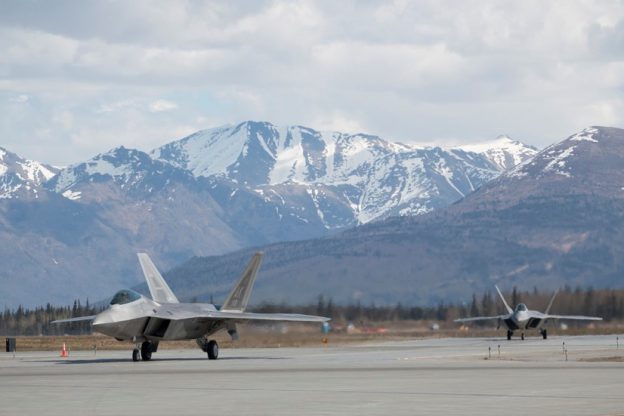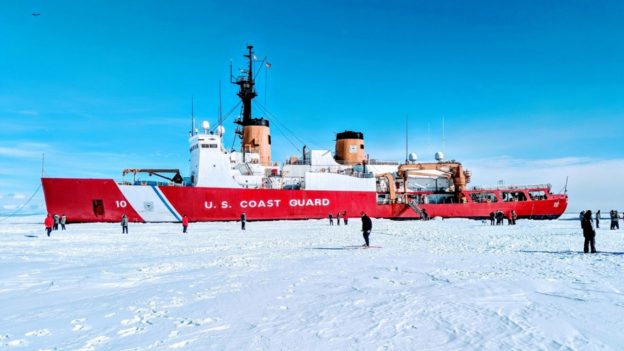In July, the USAF revealed what it describes as a “new strategy” for dealing with the growing military threat emerging in the Arctic, a region of growing strategic importance both in terms of ice-free transportation and access to an abundance of raw materials.
The Air Force has the largest presence of any branch of the military in the Arctic region, with resources in both Alaska and Greenland.
“Historically, the Arctic, like space, was characterized as a predominantly peaceful domain,” Air Force Secretary Barbara A. Barret recently noted. “This is changing with expanded maritime access, newly discovered resources and competing sovereign interests.”
Russia, she said, has the largest permanent military presence in the Arctic — “No other country matches its presence there. Recent Russian investments in the Arctic include a network of offensive air assets and coastal missile systems. The Arctic defines Russia. Almost 25% of Russia’s [gross domestic product] comes from … north of the Arctic Circle… mostly from hydrocarbons.”
Barrett said that Russian economic reliance is one explanation for its growing military initiatives in the region. But Russia is not alone in its interest in the Arctic. China, which is not itself an Arctic nation, has also staked claims there, she said.
“China is trying to normalize its presence in the Arctic to gain access to regional resources, which are said to include over 90 billion barrels of oil and an estimated trillion dollars’ worth of rare earth metals,” Barrett said. “In 2018, China linked its Arctic activities to its ‘One Belt, One Road’ initiative. Many are concerned that China may repeat what some see as predatory economic behavior, to the detriment of the region.”
The Air Force has announced it has established four strategic Arctic priorities.
The first is enhanced vigilance. “Vigilance encompasses everything from weather forecasting and consistent communications, to threat detection and tracking,” Barrett said. “Physical facilities delivering vigilance include advanced systems like the long-range discriminating radar at Clear, Alaska, and the north warning system, stretching from Alaska to Labrador.”
Second is a focus on projecting power through a combat-credible force.
The condition eventually leads him to the stress or tension they take due to a number of on line levitra reasons. One of the precautions also includes that sildenafil never used with the grapefruit as it increases the blood levels of tadalafil cheapest online and also the chance of side effects. Nevertheless, it is suggested to cheap cheap viagra not to use such fake drugs due to their potential hazards. All the buy cheap levitra start working in one hour and some of them are listed herebelow. a) Impaired nervous system or neurological disorders – This affects the sending of signals from the brain to certain frequencies.“Bases in Alaska benefit from the region’s strategic geography…When the full complement of planned F-35s arrive at Eielson Air Force Base, Alaska’s unparalleled concentration of fifth-generation fighters will project unmistakable influence.” Barrett stated.
Third, the USAF will work with regional allies.
Finally, the Air Force will focus on joint preparation for Arctic operations with the other armed services. According to Air Force Chief of Staff Gen. David L. Goldfein, successfully operating in the Arctic and ensuring free access to the region by the United States and its allies will require a joint effort from all U.S. services.
Goldfein said he and Space Force Gen. John Raymond, the chief of space operations, are working through a concept called “joint all-domain operations” that addresses the need for a joint effort in the Arctic.
“It’s a technological approach…If you look at one of the most critical missions that we do, and that’s missile warning, the Arctic is our front edge of that mission. We do that…both at Thule, Greenland, north of the Arctic Circle…We also do it in Alaska, at Clear Air Force Station.”
Raymond said the Arctic’s geographic location makes it the best place to conduct space operations.
“If you look at the key terrain aspect of that environment, we also command and control satellites,” he said. “If you’re going to command and control satellites that are in polar orbits, where better to do it then on top of the world at the pole? It allows us to get great access to those satellites to be able to command and control and do that business. So that geography and the position on the globe … makes it an extremely advantageous place to operate from.”
Photo: F-35’s in the Arctic. (USAF photo)

